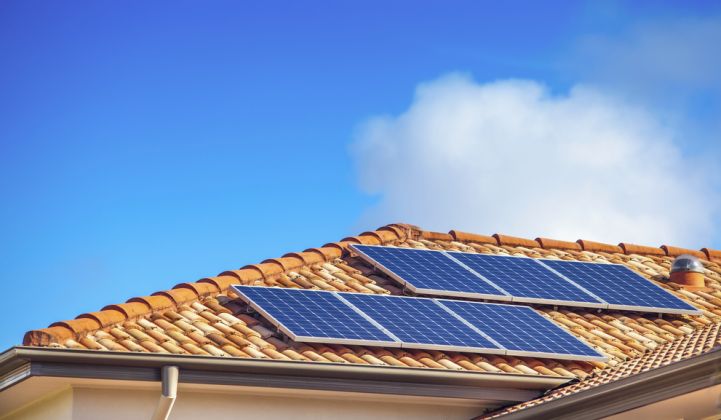The idea that utilities are tarnishing or fighting solar “couldn’t be anything further from the truth,” according to James Avery, senior president of power supply at San Diego Gas & Electric.
Avery argued at the U.S. Solar Market Insight conference yesterday that for fully decoupled utilities like his, there is no perverse incentive to oppose distributed solar, whether in a desert, on a commercial building or on a residential rooftop. If sales were cut in half, the utility's profits and shareholders don’t change.
In the last two years, SDG&E has added well over 1,000 megawatts to its system. Ten years ago, renewables made up less than 1 percent of the utility’s energy mix. Today, renewables make up 32 percent, not including behind-the-meter projects.
“From our perspective, we are relatively indifferent to what resources we acquire,” said Avery.
The reason the utility continues to add natural gas peaker plants instead of fully embracing solar is because “quite often, distributed solar is installed wrong,” he added.
Solar systems are optimized to peak between noon and 2 p.m., which means the utility still needs a resource to meet peak demand at the end of the day, around 8 p.m. The concern around California’s over-generation issue at off-peak times is represented by the infamous duck curve.
“I’m hopeful there will be other forms of resources we can use, such as energy storage, in the future,” said Avery. “But right now, the only resource I have available to do this are conventional gas turbines.”
People who say that a utility must be opposed to solar because it's adding gas turbines are wrong, he said. Similarly, people who say the utility must be against solar because it wants to reform rates are wrong, according to Avery.
“Right now, we’ve got a situation where rates were designed based on how to build for services 20 to 30 years ago; they don’t reflect the costs of doing business today,” said Avery.
In changing rate structures, “all we’re trying to do is make sure people have proper price signals,” he said.
If prices are set right, one of the first things customers will do is angle their panels further west, so their solar systems peak later in the day. If that happens, solar could play a big part in managing peak demand.
All of this sounds pretty reasonable -- except that the way rates are restructured can make a big difference.
The Wisconsin Public Service Commission, for instance, voted in favor of We Energies’ request to increase monthly fixed charges fro $9 to $16, and to require customers with solar panels to pay a new fee of roughly $4 per month. The PSC has until later this month to finalize its decision in a written order. If approved, the new solar rate structures could set the Wisconsin solar market back five years, according to GTM's senior VP of research, Shayle Kann.
Utilities are not attacking solar outright, the way they once used to, but they are hampering the competitive solar market though different rate design proposals, said Tom Starrs, vice president of market strategy and policy for SunPower.
“The most evident -- and frankly, the most troubling -- is a pretty substantial shift from variable to fixed monthly bills, which undermines the solar industry’s value proposition to customers,” he said.
Developing new solutions
As the market penetration of both distributed and utility-scale solar increases, it does create integration challenges that are a legitimate concern for utilities, said Starrs. But peaker plants are no longer the only way to fix the disconnect between solar peaking at noon and demand peaking at 8 p.m., he said. The increasing availability of energy management capabilities, demand response capabilities, and other load-shifting capabilities plus storage is allowing distributed solar, which today utilities see as part of the problem, to be part of the solution.
“Another way to resolve [the] problem is not to shift panels to the west…which decreases the overall performance of the system,” said Starrs. “But rather, [the solution would be to] have the ability to deliver that power to a battery bank and feed at noon when the sun is at its peak, and deliver back to grid at 8 p.m. or 9 p.m. when the system is at its peak.”
“That idea scaled up means we do have potential for [distributed generation] solutions, defined more broadly than just PV on the roof, that can contribute significantly to the challenges we’re all facing with respect to grid integration,” he added.
Avery joked in response: “I hate to say this, but I agree with you.”
Utilities share the goal of integrating more renewable energy, he said. The difficulty, he repeated, comes back to the current rate structure. Customers still need to be incentivized to adopt grid technologies, such as solar and storage, in order for them to help reduce peak demand in the evening.
While not exactly popular among those in the solar industry, demand changes imposed on solar customers proposed by Arizona’s Salt River Project could offer a better model for shifting solar production later in the day while stimulating other investments in the grid.
The rate-change conversation is now getting underway across the country. While the concept of the “utility death spiral” still lingers, the energy industry has largely moved past it to a point where a large number of utilities are actively developing solar strategies, albeit some less enthusiastically than others, said David Frankel, associate principal at McKinsey.
“What is interesting is that over time, even for utilities that have a pretty clear sense that [solar] is a real threat and they should do something about it, the challenge a lot of them are having is how to actually develop an integrated view across your customer business, energy supply, grid operations folks and regulatory folks,” he said. “The reality is, this is really a cross-functional challenge utilities are faced with and have to address.”



